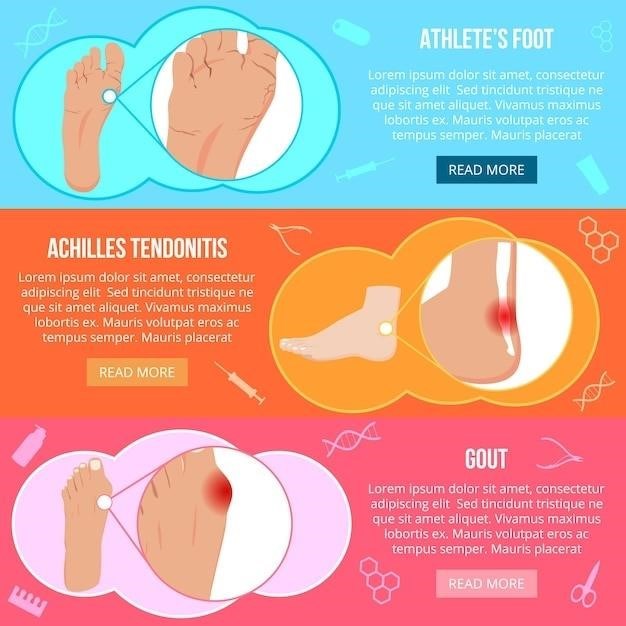Foot and Ankle Ability Measure (FAAM)⁚ A Comprehensive Overview
The Foot and Ankle Ability Measure (FAAM) is a widely used self-report questionnaire designed to assess physical function in individuals experiencing foot and ankle impairments. It’s a valuable tool for clinicians and researchers alike, offering insights into daily living and sports activities;
Introduction to the FAAM
The Foot and Ankle Ability Measure (FAAM) is a self-reported outcome measure specifically designed to evaluate the functional limitations experienced by individuals with foot and ankle problems. Developed to provide a standardized assessment of physical function, the FAAM has gained widespread acceptance among clinicians and researchers. Its effectiveness lies in its ability to quantify the impact of foot and ankle conditions on daily activities and participation in sports. The FAAM’s psychometric properties, including reliability and validity, have been extensively studied and documented, supporting its use in diverse clinical and research settings. The questionnaire’s structure allows for a comprehensive assessment of functional limitations, facilitating objective measurement of treatment effectiveness and disease progression. The availability of the FAAM in multiple languages further enhances its global applicability and accessibility.
FAAM Subscales⁚ Activities of Daily Living (ADL) and Sports
The FAAM questionnaire is cleverly structured into two distinct subscales⁚ Activities of Daily Living (ADL) and Sports. The ADL subscale focuses on assessing the impact of foot and ankle problems on everyday tasks, such as walking, stair climbing, and performing household chores. This section helps clinicians understand how the condition affects a patient’s ability to manage their daily routines and maintain independence. Conversely, the Sports subscale delves into the effects on sporting activities and recreational pursuits. This is crucial for athletes and active individuals, allowing for a targeted assessment of limitations in their physical capabilities related to sports participation. Both subscales employ a standardized rating system, enabling objective comparison of functional abilities and progress over time. The combined data from both subscales provides a comprehensive picture of the overall impact of the foot and ankle condition on the patient’s quality of life.
Reliability and Validity of the FAAM
Extensive research supports the FAAM’s reliability and validity as a measurement tool. Reliability refers to the consistency of the results; studies have shown that the FAAM produces consistent scores when administered repeatedly to the same individuals. This ensures that any changes in scores reflect genuine changes in the patient’s condition, not simply variations in test administration. Validity, on the other hand, confirms that the FAAM accurately measures what it intends to measure – physical function in individuals with foot and ankle problems. This is established through various methods, including comparing FAAM scores with objective measures of physical performance and other established outcome measures. The strong evidence for both reliability and validity makes the FAAM a trusted instrument in clinical practice and research, providing clinicians and researchers with confidence in the accuracy and dependability of the data it yields.

Applications of the FAAM
The FAAM finds broad application in clinical settings and research, aiding in diagnosis, treatment planning, and monitoring progress in patients with foot and ankle conditions.
Use in Clinical Settings
In clinical practice, the Foot and Ankle Ability Measure (FAAM) serves as a crucial tool for assessing patient function and treatment efficacy. Physical therapists and other healthcare professionals utilize the FAAM to objectively measure a patient’s ability to perform activities of daily living (ADL) and sports-related activities. The questionnaire’s straightforward design facilitates easy administration and patient understanding. The FAAM’s scores provide quantifiable data that allows clinicians to track improvements over time, tailoring treatment plans to specific patient needs. Furthermore, the FAAM helps in identifying areas requiring specific intervention, whether it’s improving mobility, reducing pain, or enhancing overall functional capacity. By using the FAAM, clinicians can make data-driven decisions regarding treatment duration and discharge planning, ensuring patients receive the most effective and timely care. The FAAM’s ability to quantify improvements contributes to better communication between healthcare professionals and patients, fostering a shared understanding of progress and goals. The consistent use of FAAM data enhances the quality of care provided and improves overall patient outcomes. This valuable assessment tool streamlines clinical decision-making and improves patient care.
Research Applications of the FAAM
The Foot and Ankle Ability Measure (FAAM) plays a significant role in various research settings, providing a standardized method for assessing foot and ankle function across diverse studies. Researchers utilize the FAAM to compare the effectiveness of different interventions, such as surgical techniques or physical therapy regimens, in treating foot and ankle conditions. Its reliable and valid design ensures consistent and comparable results across different studies and populations. The FAAM’s ability to measure both ADL and sports-specific activities allows researchers to assess the impact of interventions on various aspects of daily life and physical performance. This detailed assessment helps in understanding the overall effect of treatments on patients’ quality of life. Furthermore, the FAAM facilitates the investigation of correlations between foot and ankle function and other health outcomes. This allows researchers to gain a more comprehensive understanding of the impact of foot and ankle problems on overall health and well-being. The availability of the FAAM in multiple languages enhances its international applicability, enabling larger-scale comparative studies and global collaborations. This widespread use ensures a broader understanding of foot and ankle conditions and their management worldwide.
FAAM Versions and Translations
The FAAM’s accessibility is enhanced by its availability in multiple languages and versions tailored for specific populations, ensuring broader applicability and inclusivity in research and clinical practice.
Availability in Multiple Languages
The global reach and utility of the Foot and Ankle Ability Measure (FAAM) are significantly amplified by its translation into numerous languages. This multilingual accessibility ensures that researchers and clinicians worldwide can effectively utilize the FAAM, regardless of linguistic barriers. The availability of the FAAM in languages beyond English, such as German, French, and Persian, as evidenced in various research publications and online resources, demonstrates a commitment to inclusive assessment practices. This broad linguistic coverage facilitates cross-cultural comparisons and promotes a more comprehensive understanding of foot and ankle function across diverse populations. The existence of validated translations is crucial for the accurate and reliable interpretation of FAAM scores, supporting meaningful clinical decisions and robust research findings. Furthermore, the availability of multiple language versions underscores the instrument’s international recognition and acceptance as a leading measure of foot and ankle function.
Different Versions for Specific Populations
While the core FAAM questionnaire provides a comprehensive assessment of foot and ankle function, the need for specialized versions tailored to specific populations has been recognized. These adapted versions often account for unique activity levels, injury profiles, or underlying conditions prevalent within particular demographics. For instance, a version might be designed specifically for athletes, focusing on sports-related activities, or for elderly individuals, considering their typical daily routines and physical limitations. Such adaptations ensure the FAAM remains sensitive and relevant to the specific needs of different patient groups, leading to more accurate and nuanced assessments. This approach emphasizes the instrument’s flexibility and adaptability to diverse clinical settings, thereby enhancing its overall utility and reliability. The development and validation of these specialized versions are critical for maximizing the FAAM’s clinical impact and fostering more inclusive research.

Strengths and Limitations of the FAAM
The FAAM offers strong reliability and validity, making it a valuable assessment tool. However, its self-reported nature introduces potential biases and limitations in certain populations requiring careful consideration.
Advantages of Using the FAAM
The Foot and Ankle Ability Measure (FAAM) provides several key advantages for assessing patient function. Its widespread use and availability in multiple languages facilitate comparisons across diverse populations and research studies. The FAAM’s established reliability and validity ensure consistent and accurate measurement of functional limitations, enabling clinicians to track progress effectively and tailor interventions accordingly. The instrument’s relatively short completion time contributes to efficient clinical workflow, minimizing patient burden. Furthermore, the FAAM’s distinct subscales (Activities of Daily Living and Sports) offer a granular perspective on functional limitations, allowing for a more comprehensive understanding of the patient’s condition. This detailed assessment helps guide treatment planning and monitor the effectiveness of interventions more precisely, leading to better patient outcomes. The clear scoring system simplifies data analysis and interpretation, streamlining the clinical decision-making process. The FAAM’s established psychometric properties support its use in various research settings, contributing to a robust evidence base for foot and ankle rehabilitation.
Considerations and Potential Drawbacks
While the FAAM offers significant benefits, certain considerations and potential drawbacks should be acknowledged. The self-reported nature of the FAAM means responses may be influenced by factors like recall bias, patient motivation, and interpretation of questions. Cognitive impairments or literacy limitations can affect accurate completion, potentially under- or overestimating true functional abilities. The FAAM primarily focuses on self-perceived function and may not fully capture objective physical performance. Cultural differences in understanding activities or interpreting response scales could lead to variations in scores. The FAAM’s specificity to foot and ankle issues might limit its applicability in cases with co-morbidities affecting other body regions. Clinicians should consider these factors when interpreting FAAM scores and integrate them into a comprehensive assessment that involves objective measurements and clinical observation. Over-reliance on the FAAM without considering other assessment tools could lead to incomplete or inaccurate evaluations. Therefore, a holistic approach is crucial for optimal patient care.
Leave a Reply
You must be logged in to post a comment.